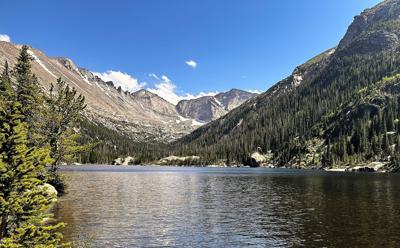As Lancaster County baked in sweltering heat two weeks ago, with temperatures holding steady for days in the upper 90s, fields of snow covered north-facing slopes high in the Rocky Mountains.
Rocky Mountain National Park covers 265,807 acres – 415 square miles – of rugged and picturesque country just west of Estes Park in Colorado.
While the land was acquired by the U.S. government in 1803 as part of the Louisiana Purchase, Rocky Mountain National Park was dedicated into the national park system in 1915 by President Woodrow Wilson. It was the ninth national park dedicated in the U.S.
It’s one of the highest national parks in the U.S., with elevations from about 7,800 feet to over 14,000 feet.
READ: Fishing and sightseeing on Utah's scenic Green River
The highest point in the park is Longs Peak, which reaches 14,259 feet.
One thing that makes Rocky Mountain National Park unique is it features three ecosystems – montane, subalpine and alpine.
The montane level harbors a variety of plant life suited for altitudes below 9,000 feet – wildflowers, aspens, willows, birch and many others.
The subalpine region has plants unique to 9,000-11,400 feet. For trees, you’re looking mainly at spruce and pines.
And the alpine zone harbors organisms that can bear life above 11,400 feet. Here you’ll find many of the same plants you’d see on the Arctic tundra – lichens, sedges, varieties of hardy wildflowers.
One of the primary draws to Rocky Mountain National Park has to be the wildlife. And just like the plant life, you’ve got animals that live down at the lower elevations, and animals that can live up high.
Pronghorn antelope, mule deer, elk, moose, bighorn sheep and black bears top the list of the most sought after big game species in the park.
Elk and deer are probably the easiest to find.
Along the hiking trails, count on seeing plenty of snowshoe hares, golden-mantled ground squirrels, chipmunks and pikas.
Most animals in the park seem to be at least somewhat habituated to people.
They won’t let you pet them – nor should you try.
But they won’t speed away the moment they spot you, either.
It’s clear they’re used to seeing people, and have figured out we aren’t much of a threat to them.
Here are four things to know about planning a trip to Rocky Mountain National Park.
READ: Here are 13 great hiking trails for summertime in Lancaster County
1. It’s busy
Rocky Mountain has everything to give you that true wilderness feeling. It’s got the tall, snow-capped mountains and the endless swaths of evergreen forests, all well off the paved surfaces.
But when you spend 8 hours on a trail and you’re constantly stopping to let others pass, it sure doesn’t feel like you’re really “out there.”
According to a USA Today study, Rocky Mountain was the fifth most-visited national park in 2023, with just over 4.1 million visitors. That’s up over 1 million visitors as compared to 2010.
To alleviate congestion at the entrances, the park has instituted a timed entry system, which requires visitors to obtain entry tickets that stagger the times when they can enter.
This system runs from late May through October, between 9 a.m. and 2 p.m.
But once you’re in, you’re in. And so you can be at Emerald Lake, 4 miles back in from the Bear Lake Trailhead, and still be surrounded by 100 other people.
Summer is peak season at Rocky Mountain. If possible, consider going in late September before the snow starts falling, to beat the crowds and get that wilderness experience.
You might consider going early in the season to find some solitude, but then you’re fighting winter. Many areas of the park were closed due to deep snow well into May this year.
READ: Finding community and climate change on an overseas adventure
2. Go Camping
One of the best ways to experience all the park has to offer is to never leave it. Make the park your home during your visit by camping.
There are four campgrounds within the park that offer varying amenities and which are open at different times.
We recently stayed at Glacier Basin Campground, where people stayed in tents, camping trailers and RVs.
It was a short hike away from Sprague Lake, which was a mecca for big game early in the morning and right before sunset every day.
We saw elk, moose and mule deer in and around the lake, which was teeming with trout, so bring your rod.
As a camping guest in the park, you don’t have to worry about timed-entry passes. Your camping pass allows you to go where you want, when you want, in the park.
READ: On the Outer Banks, wild horses have been a constant over centuries
3. Drive Trail Ridge Road
Spanning 48 miles from Estes Park on the east side of Rocky Mountain park, to Grand Lake on the west, Trail Ridge Road takes you up, up and away.
Eleven miles of Trail Ridge Road sit in the alpine zone, which is above the treeline at 11,500 feet.
At its highest point, the road reaches 12,183 feet.
Up there, count on strong winds and temperatures at least 20 degrees cooler than what you left in Estes Park or at Grand Lake.
At 11,796 feet, you’ll pass the Alpine Visitor Center, which is the highest elevation visitor center in the National Park System.
The visitor center offers a museum, a store, bathrooms, café and some incredible scenery.
It’s only open during the summer, and it can close at any time if the weather gets nasty.
The real treat of Trail Ridge Road is the never-ending array of spectacular views of the Rocky Mountains and the valleys below.
Every twist and turn of the road offers new, postcard-worthy vistas.
READ: Trout-fishing paradise can be found at Penns Creek
4. Take a Hike
As beautiful as the drive is on Trail Ridge Road, it’s not the same as immersing yourself in the natural world of Rocky Mountain National Park by lacing up your boots and hitting the trails.
You can’t hear from your car the sound of a breeze wafting through a stand of lodgepole pines.
You can’t smell from your car the scent of subalpine firs growing on the slopes leading up to Longs Peak.
And there’s no way to dunk aching feet into the chilly, snowmelt-fed water of Dream Lake from the seat of your SUV.
The only way to experience the wild side of Rocky Mountain National Park is on the trails.
Feel the difference in your lungs between hiking at 7,000 feet and hiking at 11,000 feet.
Crossing paths with a mule deer 5 miles deep in the forest is different than watching one graze between tents in the campground.
Park maps and information sheets are littered with suggested hikes of varying lengths, altitude and intensity.
Whether you want a short, leisurely stroll or a challenging, all-day climb, there are options galore for hiking in Rocky Mountain National Park.
For all kinds of information on Rocky Mountain National Park, go to nps.gov/romo.










![Historical finds can be dug up along the Susquehanna River with help from Blue Rock Heritage Center [column]](https://bloximages.newyork1.vip.townnews.com/lancasteronline.com/content/tncms/assets/v3/editorial/8/8c/88c15e04-2e48-11ef-af2a-639305dc0afc/6672eb9dd4141.image.jpg?resize=150%2C100)
![25 years of sleeping in the snow in Pennsylvania’s wildest place [column]](https://bloximages.newyork1.vip.townnews.com/lancasteronline.com/content/tncms/assets/v3/editorial/0/09/0094d66a-cb46-11ee-8f01-f7afa09600e1/65cccf50dfd92.image.jpg?resize=150%2C81)
 AD CRABLE | Outdoors Columnist
AD CRABLE | Outdoors Columnist